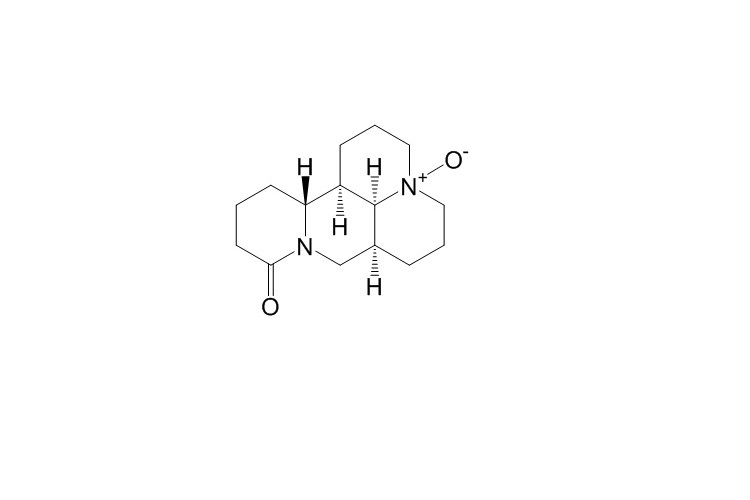Home
Products
Oxymatrine



| Product Name | Oxymatrine |
| Price: | $15 / 20mg |
| Catalog No.: | CN02153 |
| CAS No.: | 16837-52-8 |
| Molecular Formula: | C15H24N2O2 |
| Molecular Weight: | 264.4 g/mol |
| Purity: | >=98% |
| Type of Compound: | Alkaloids |
| Physical Desc.: | Powder |
| Source: | The roots of Sophora flavescens Ait |
| Solvent: | Chloroform, Dichloromethane, Ethyl Acetate, DMSO, Acetone, etc. |
| SMILES: | O=C1CCC[C@H]2N1C[C@@H]1CCC[N@+]3([C@@H]1[C@@H]2CCC3)[O-] |
| Contact us | |
|---|---|
| First Name: | |
| Last Name: | |
| E-mail: | |
| Question: | |
| Description | Oxymatrine, an alkaloid from the roots of Sophora species, with anti-inflammatory, antifibrosis, and antitumor effects, inhibits the iNOS expression and TGF-β/Smad pathway. |
| In Vitro | Oxymatrine, an alkaloid component extracted from the roots of Sophora species, has been shown to have antiinflammatory, antifibrosis, and antitumor effects and the ability to protect against myocardial damage, etc. The potential signaling pathways involved in the clinical application of oxymatrine might include the TGF-β/Smad, tolllike receptor 4/nuclear factor kappa-light-chain-enhancer of activated B cells, toll-like receptor9/TRAF6, Janus kinase/signal transduction and activator of transcription, phosphatidylinositol-3 kinase/Akt, delta-opioid receptorarrestinl-Bcl-2, CD40, epidermal growth factor receptor, nuclear factor erythroid-2-related factor 2/hemeoxygenase-1 signaling pathways, and dimethylarginine dimethylaminohydrolase/asymmetric dimethylarginine metabolism pathway[1]. Oxymatrine significantly inhibits the proliferation of DU145 and PC-3 cell lines in a time- and dose-dependent manner. By contrast, following treatment with oxymatrine, PNT1B healthy human prostate cell proliferation is not inhibited[2]. |
| In Vivo | The volume and weight of tumors in mice significantly decreased in a dose-dependent manner. Oxymatrine may reduce prostate cancer cell growth by promoting cell apoptosis in vivo[2]. Oxymatrine is effective in reducing the production and deposition of collagen in the liver tissue of experimental rats. Oxymatrine could promote the expression of Smad 7 and inhibit the expression of Smad 3 and CBP in CCl4-induced hepatic fibrosis in SD rats, could modulate the fibrogenic signal transduction of TGFβ-Smad pathway[3]. |
| Cell Assay | DU145, PC-3 and PNT1B cell lines (3×104 cells/well) are seeded into 96-well plates and incubated overnight at 37°C in 5% CO2. Subsequently, the cells are incubated with different concentrations of oxymatrine (0, 2, 4, 6 and 8 mg/mL). MTT (10 mL; 5 mg/mL) is added and the mixture is incubated in darkness at 37°C for 2 h. Absorbance is measured at a wavelength of 490 nm using a microplate reader[2]. |
| Animal Admin | Rats: One hundred healthy male SD rats (weight 140-160 g) are used in the study. All 100 rats are randomLy divided into three groups: Control (n=20), Treatment (n=40) and Model group (n=40). For the model group, 300 g/L CCl4 soluted in liquid paraffin is injected subcutaneously at a dosage of 3 mL/kg twice per week[6]. The treated rats receive Oxymatrine celiac injections at 10 mg/kg twice a week besides the injection of CCl4[3]. Mice: BALB/c homozygous (nu/nu) nude mice are used in the study. 24 tumor-bearing mice are randomLy divided into three groups: The control group is treated with PBS, and two groups are treated with different concentrations of oxymatrine (50 mg/kg and 100 mg/kg body weight). Oxymatrine is administered to the mice, using daily intraperitoneal injections[2]. |
| Exact Mass | 264.183777 |
| PSA | 49.74000 |
| LogP | -0.35 |
| Vapour Pressure | 0mmHg at 25°C |